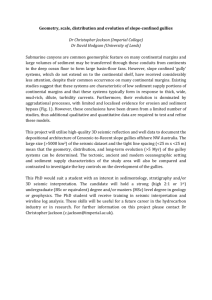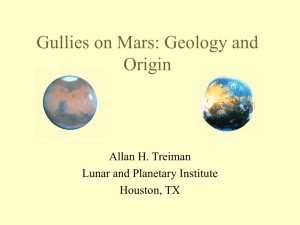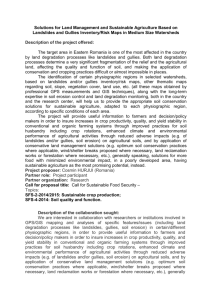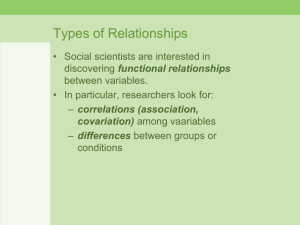Gullies on Vesta Gullies on Vesta Jennifer Scully et al., 8 May 2013
advertisement
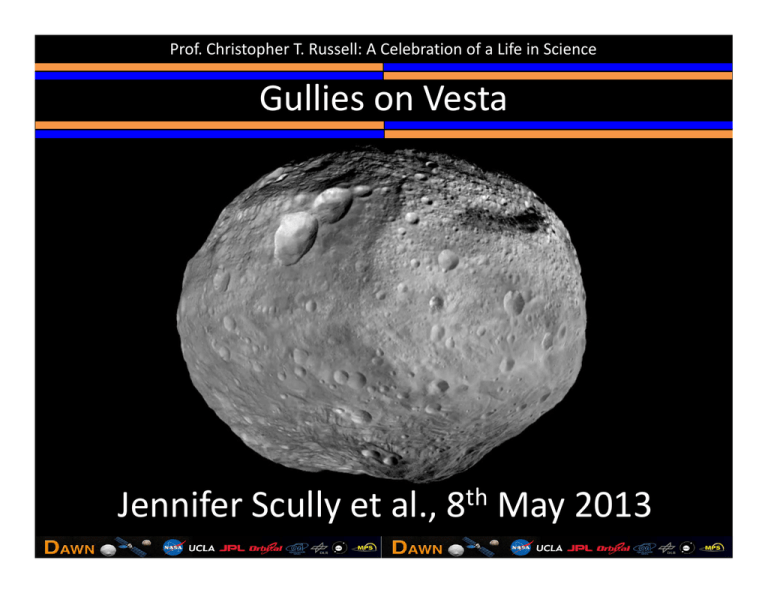
Prof. Christopher T. Russell: A Celebration of a Life in Science Gullies on Vesta Gullies on Vesta Jennifer Scully et al., 8th May 2013 Prof. Christopher T. Russell: A Celebration of a Life in Science Introduction | Linear | Curvilinear | Gullies summary | Water flow | Formation Mechanism | Conclusions Tk h Take home messages • Two Two types of gullies identified on Vesta: curvilinear and types of gullies identified on Vesta: curvilinear and linear • Curvilinear gullies formed by transient flow of liquid water • Sourced in subsurface ice‐bearing deposits • First morphological evidence to suggest that Vesta is not as dry as previously thought Prof. Christopher T. Russell: A Celebration of a Life in Science Introduction | Linear | Curvilinear | Gullies summary | Water flow | Formation Mechanism | Conclusions 2t 2 types of gullies identified on Vesta f lli id tifi d V t • Two types of gullies: different morphologies & network yp g p g geometries • 48 craters containing linear type gullies • 11 craters containing curvilinear type gullies • Gullies Gullies in craters that are relatively young, e.g. Marcia in craters that are relatively young, e.g. Marcia ~60‐ 60 150 Ma (Williams et al. 2013) Prof. Christopher T. Russell: A Celebration of a Life in Science Introduction | Linear | Curvilinear | Gullies summary | Water flow | Formation Mechanism | Conclusions Li Linear gullies example: Fonteia crater lli l F t i t Prof. Christopher T. Russell: A Celebration of a Life in Science Introduction | Linear | Curvilinear | Gullies summary | Water flow | Formation Mechanism | Conclusions Li Linear gullies in Fonteia: detailed map lli i F t i d t il d • Originate in alcoves below spurs below spurs • Linear, straight channels • Parallel channels • Rarely intersect • Low length to width ratio width ratio • Sometimes end in lobate deposits lobate deposits • Bounded by levees Prof. Christopher T. Russell: A Celebration of a Life in Science Introduction | Linear | Curvilinear | Gullies summary | Water flow | Formation Mechanism | Conclusions A l Analogous to lunar gullies t l lli Kumar et al. (2013) Prof. Christopher T. Russell: A Celebration of a Life in Science Introduction | Linear | Curvilinear | Gullies summary | Water flow | Formation Mechanism | Conclusions C ili Curvilinear gullies example: Cornelia crater lli l C li t Note pitted terrain Prof. Christopher T. Russell: A Celebration of a Life in Science Introduction | Linear | Curvilinear | Gullies summary | Water flow | Formation Mechanism | Conclusions C ili Curvilinear gullies in Cornelia: detailed map lli i C li d t il d Prof. Christopher T. Russell: A Celebration of a Life in Science Introduction | Linear | Curvilinear | Gullies summary | Water flow | Formation Mechanism | Conclusions C ili Curvilinear gullies in Cornelia: detailed map lli i C li d t il d • Originate below cliff base/ V‐shaped alcoves • Frequently intersect • Curvilinear, sinuous channels • High length to width ratio • Dendritic to subparallel networks • Some end in superposing lobate deposits Prof. Christopher T. Russell: A Celebration of a Life in Science Introduction | Linear | Curvilinear | Gullies summary | Water flow | Formation Mechanism | Conclusions A l Analogous to terrestrial and martian gullies i l d i lli Malin & Edgett (2000) Prof. Christopher T. Russell: A Celebration of a Life in Science Introduction | Linear | Curvilinear | Gullies summary | Water flow | Formation Mechanism | Conclusions Li Linear & curvilinear gullies have different morphologies & ili lli h diff h l i Curvilinear gullies gullies Linear gullies Linear gullies Prof. Christopher T. Russell: A Celebration of a Life in Science Introduction | Linear | Curvilinear | Gullies summary | Water flow | Formation Mechanism | Conclusions Wh t What processes formed the gullies? f d th lli ? • Impact melt has been ruled out for both gully types • Morphologies & network geometries of linear gullies consistent with dry granular flow i t t ith d l fl • Morphologies & network geometries of curvilinear gullies resemble those formed by flow of liquid water Prof. Christopher T. Russell: A Celebration of a Life in Science Introduction | Linear | Curvilinear | Gullies summary | Water flow | Formation Mechanism | Conclusions E id Evidence for volatiles & water on Vesta f l til & t V t • Pitted terrain: formed by impact‐induced degassing of volatile material (Denevi et al. 2012) ‐> associated with curvilinear gullies NASA/JPL‐Caltech/UCLA/MPS/DLR/IDA/JHUAPL Prof. Christopher T. Russell: A Celebration of a Life in Science Introduction | Linear | Curvilinear | Gullies summary | Water flow | Formation Mechanism | Conclusions E id Evidence for volatiles & water on Vesta f l til & t V t • From meteorites: ‐ quartz & other mineral veins => aqueous alteration (Treiman et al. 2004, Warren et al. 2013) ‐ high OH apatites => water in magmas hi h OH i i (Sarafian et al. 2012) ‐ carbonaceous chondrite clasts (e.g. Herrin et al. 2011) 0.5 mm • From Dawn data: ‐ dark material is carbonaceous chondrite (Reddy et al. 2012) ‐ areas of OH f OH (De Sanctis et al. 2012) ‐ areas high in H (Prettyman et al. 2012) Prof. Christopher T. Russell: A Celebration of a Life in Science Introduction | Linear | Curvilinear | Gullies summary | Water flow | Formation Mechanism | Conclusions F Formation mechanism of curvilinear gullies ti h i f ili lli Prof. Christopher T. Russell: A Celebration of a Life in Science Introduction | Linear | Curvilinear | Gullies summary | Water flow | Formation Mechanism | Conclusions C l i Conclusions & implications & i li ti • Curvilinear gullies formed by transient flow of liquid water, sourced in subsurface ice‐bearing deposits • First morphological evidence to suggest that Vesta is not as dry as previously thought • Vesta is a diverse, heterogeneous and complex mini‐world with planetary style processes planetary‐style processes • Should not be surprised by possible presence of water on other h ld b i db ibl f h asteroids Prof. Christopher T. Russell: A Celebration of a Life in Science Th k Thank you! ! 2, H. Y. McSween 3, C. T. Russell C TR ll1, A. Yin A Yi 1, R. Jaumann R J H YM S C. A. Raymond4, V. Reddy5, 6, L. Le Corre5, 7. 1Department of Earth and Space Sciences, University of California, Los Angeles, California 90095‐1567, USA. D t t f E th d S S i U i it f C lif i L A l C lif i 90095 1567 USA 2DLR, Institute of Planetary Research, Berlin, Germany. 3 Department of Earth and Planetary Sciences, University of Tennessee, Knoxville, TN, 37996‐1410, USA. 4Jet Propulsion Laboratory, California Institute of Technology, Pasadena, CA, USA. 5Max Planck Institute, Katlenburg‐Lindau, Germany. M Pl k I tit t K tl b Li d G 6University of North Dakota, Grand Forks, ND, USA. 7Planetary Science Institute, Tucson, AZ, USA. We thank B.W. Denevi, K. Otto and D.P. O’Brien. We also thank the Dawn team for the development, cruise, orbital insertion and operations of the Dawn spacecraft at Vesta the Dawn spacecraft at Vesta. Prof. Christopher T. Russell: A Celebration of a Life in Science Th k Thank you! ! Dawn team at G ld t Goldstone Deep Space D S Network, January 2011 Prof. Christopher T. Russell: A Celebration of a Life in Science Additi Additional slides l lid Prof. Christopher T. Russell: A Celebration of a Life in Science R l Relevant basic facts about Vesta tb i f t b tV t 1. Average radius: 262 km (Russell et al. 2012) 2. Differentiated: iron core, olivine mantle & basaltic crust Russell et al (2012) & Ermakov (in prep ) Russell et al. (2012) & Ermakov (in prep.) 3. Parent body of howardite, eucrite & diogenite (HED) meteorites t it (Russell et al. 2012, De Sanctis et al. 2012, Prettyman et al. 2012) 4. Little impact melt is anticipated or observed (Williams et al. 2013) 4. Little impact melt is anticipated or observed (Williams et al. 2013) 5. Dark material is exogenous (carbonaceous chondrite) & bright material is endogenous (freshly exposed) (Reddy et al. 2012, McCord et al. 2012) Prof. Christopher T. Russell: A Celebration of a Life in Science Introduction | Linear | Curvilinear | Gullies summary | Water flow | Formation Mechanism | Conclusions Li Linear & curvilinear gullies have different morphologies & ili lli h diff h l i Curvilinear gullies Linear gullies Originate below base of cliffs/ in Originate in alcoves below spurs V‐shaped alcoves Curvilinear, sinuous channels Linear, straight channels Subparallel to dendritic Parallel networks networks t k Rarely intersect Frequently intersect L length to width ratio Low l th t idth ti Hi h length to width ratio High l th t idth ti Sometimes end in larger lobate Sometimes end in smaller deposits & bounded by levees deposits & bounded by levees lobate deposits covered by lobate deposits, covered by pitted terrain Prof. Christopher T. Russell: A Celebration of a Life in Science M h l i Morphologies consistent with sapping i t t ith i Characteristic Typical for curvilinear gullies? 1. Constant channel width Yes: 50±10 m 2. Dendritic network geometry Yes 3. Long main valleys & short, stubby tributaries Yes 4 High tributary junction angles 4. High tributary junction angles Yes 5. Sapping below permeable layer Yes 6 Plots of of characteristics of 6. Pl t f f h t i ti f Y Yes sapping channels on Earth • Groundwater/ Groundwater/ aquifer origin has been suggested for some aquifer origin has been suggested for some Martian gullies (e.g. Malin & Edgett 2000, Heldmann et al. 2007) Prof. Christopher T. Russell: A Celebration of a Life in Science F Forming the curvilinear gullies i th ili lli • Morphologies of curvilinear gullies are consistent with groundwater sapping => probable formation mechanism Cross section view of one Cross section view of one side of crater: Curvilinear gullies formed by sapping Impermeable Impermeable layer Water Impermeable layer p y Adapted from Luo (2000) Prof. Christopher T. Russell: A Celebration of a Life in Science F Formation mechanism of curvilinear gullies ti h i f ili lli • Pressure‐temperature diagram for H2O ~145 K Prof. Christopher T. Russell: A Celebration of a Life in Science F Formation mechanism of curvilinear gullies ti h i f ili lli • Water is stable as a gas on Vesta’s surface, however, • Water will not all instantaneously evaporate Water will not all instantaneously evaporate • Top Top layers will evaporate while sub layers will evaporate while sub‐layers layers are protected are protected and can flow [experiments soon!] • Evaporation takes at least ~97 hrs • Gullies can be carved in ≥22 minutes G lli b d i ≥22 i t
